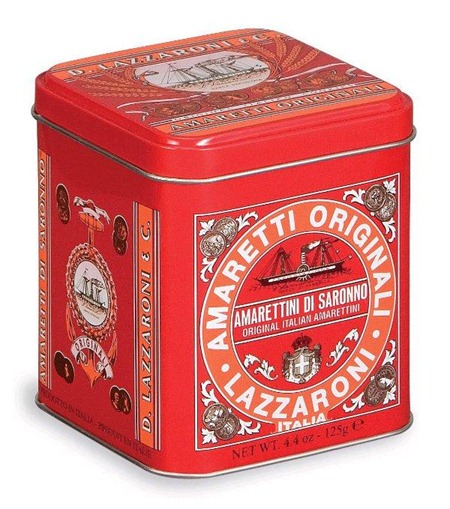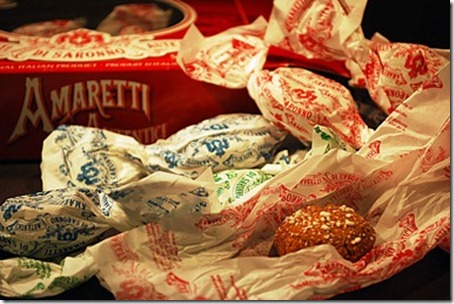Gli Amaretti di Saronno Posted by Geoff on Nov 20, 2012 in Uncategorized
I see this bright red tin a hundred times a day. It sits on a shelf in our kitchen and is full of delicious … croccantini (cat biscuits)! Yes, an empty Amaretti di Saronno tin makes the perfect storage container for dried cat food, and none of our six gatti have yet worked out how to prise the lid off, although I’m sure they’ve tried. Delicate little Gigia la gatta once persuaded our greedy giant of a tomcat, Cocò, to rip a hole in a plastic bag full of croccantini that we’d carelessly left on top of the washing machine. I later discovered them sneakily feasting together on the floor of the sgabuzzino (pantry). I had very stern words with them before ejecting them both from the window (don’t worry, it was on the ground floor).
This morning, scouring my brain for blog ideas, I found myself staring at la famosa scatola (the famous tin), and asking myself “what do I actually know about its original contents, the small dry almond flavoured biscuits known as Amaretti di Saronno?”. Well, apart from the fact that they contain almonds, virtually nothing! Ora di informarmi meglio.
Here’s what I discovered.
Amaretti have two very distinctly Italian characteristics: a legend, and simplicity. Yes, it seems that the most famous Italian culinary delights were never simply accidentally discovered by Tizio (Joe Blogs) when he was messing around in the kitchen one day. That just doesn’t cut it with the Italian’s romantic imagination, and anyone who thinks that food is simply a prosaic form of nutrition has got a lot to learn about Italian culture! In this particular case the legend tells us that: nel 1718 il Cardinale di Milano decise di recarsi in visita al Santuario della Beata Vergine dei Miracoli di Saronno. In onore della sua visita una giovane coppia preparò un impasto a base di zucchero, armelline e bianco d’uovo che, cotto in forno, diede origine ai famosi biscotti tondi che vennero chiamati Amaretti. In 1718 the Cardinal of Milan decided to pay a visit to the sanctuary of the Blessed Virgin of Miracles of Saronno. In honour of his visit a young couple prepared a pastry based on sugar, bitter almonds, and egg white that, when cooked in the oven, became the famous round biscuits that were later called amaretti (N.B. the name amaretti comes from the word amaro = bitter, hence: ‘little bitters’).
Legends come in very handy, of course, when the true origins of a something are obscure. It’s very likely in fact that amaretti originally came from the Arabic countries, being introduced into Italy via Sicily, and eventually becoming diffused throughout the peninsula. What we do know is that the Lazzaroni family moved from Teglio to Saronno at the beginning of the 1800’s, where they set up a workshop to produce their now famous biscuits under the company name D. Lazzaroni & C. which they founded in 1888. Lazzaroni were soon exporting their pastries all over the world, hence the depiction of a steamboat which you can see incorporated in their distinctive logo. (see photo of tin)
Amaretti are also famous for their wrappers, and I’m going to let Serena explain why.
Gli Amaretti di Saronno sono avvolti a due a due come caramelle in quadrati di carta velina, ciascuno decorato in rosso, in verde o in blu, e dotato di proprietà magiche. Quando eravamo bambini, in quelle rare occasioni festive in cui mangiavamo gli amaretti, facevamo molta attenzione a non rovinare l’involucro di carta, poi col pollice lo stiravamo bene in modo da togliere tutte le grinze, e infine lo consegnavamo a papà. Mio padre arrotolava ciascun pezzo di carta in un tubo, lo metteva in piedi sul tavolo, e poi dava fuoco tutt’intorno al margine superiore, mentre noi trattenevamo il respiro. Dopo qualche istante il tubo di carta fiammeggiante si sollevava dal tavolo e volava per la stanza creando dei motivi magici.
Click on the picture below to watch a video demonstration. N.B. it seems that modern day wrappers don’t work any more ![]() … health and safety regulations? In the video, at 0:09, you’ll hear: “Ai tempi antichi era perfetto usare … gli Amaretti di Saronno, anzi le carte degli Amaretti di Saronno” (In ancient times the perfect thing to use was … Amaretti di Saronno, or rather the wrappers of Amaretti di Saronno)
… health and safety regulations? In the video, at 0:09, you’ll hear: “Ai tempi antichi era perfetto usare … gli Amaretti di Saronno, anzi le carte degli Amaretti di Saronno” (In ancient times the perfect thing to use was … Amaretti di Saronno, or rather the wrappers of Amaretti di Saronno)

Build vocabulary, practice pronunciation, and more with Transparent Language Online. Available anytime, anywhere, on any device.







Comments:
Ambra Sancin:
Hi Geoff, I’ve just posted on my blog ‘The Good, the Bad and the Italian’ and put a link to your post about Amaretti di Saronno in case readers were interested in the folklore/story. Hope that’s OK? Here’s link to the post called ‘Lurking in the Cupboard: Metal Food Tins”. cheers, Ambra http://ambradambra.wordpress.com/2013/01/23/lurking-in-the-cupboard-4-metal-food-tins/
Geoff:
@Ambra Sancin Ciao Ambra, I’m not sure if you speak Italian, so I’ll write in English. You’re very welcome to link to our blog, and thanks for letting me know. So often we find our blogs reproduced around the net, and people don’t even bother to credit the author.I enjoyed reading your ‘Metal Food Tins’ blog, I love those classic designs!
A presto, saluti da Geoff